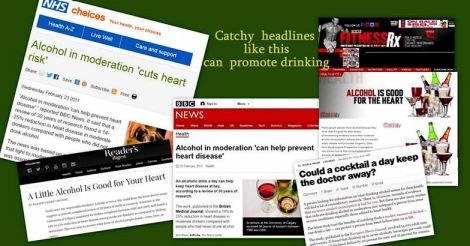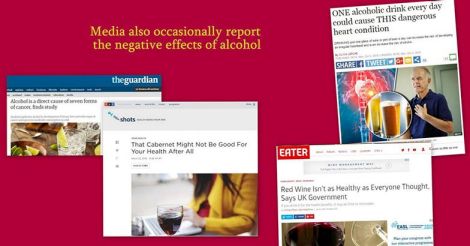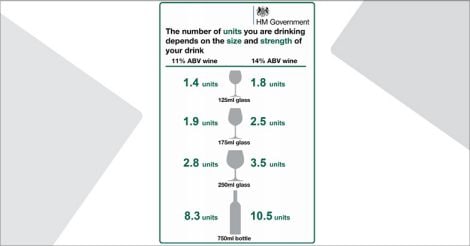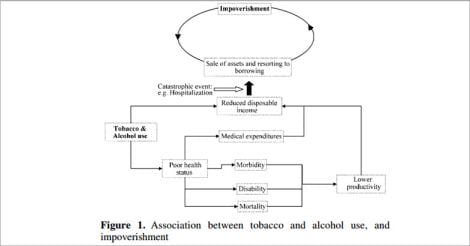“People willingly believe what they want to believe.”
-Julius Caesar

“Alcohol in moderation is good for the heart” is a commonly heard, oft-repeated statement that drinkers use as a convenient excuse to abuse alcohol. Is this really a scientific fact or just a popular myth? This article examines the truth behind that statement, in the process uncovering the bare and updated facts about alcohol use and health.
Why is continued research important?
Research is the foundation of science. Even though mankind has existed over 200,000 years, much of the progress achieved in modern medicine and technology is owed to systematic research done over the past 400 years. There was a time not so long ago when seemingly smart people believed that the earth was flat and that diseases were caused by evil spirits. However, with intelligent observations coupled with scientific interpretation, truth gradually emerged -- one step at a time.
Human lifespan has now tripled, after science defeated many apparently incurable illnesses. With more research, newer truths will no doubt get discovered, and at least some of what we believe today as absolute truth will be proved to be false in the future.
Also Read: Everyday Health | Scary but true: Psychiatric illness is more common than we think
Everyday Health | Medical hoaxes: if it sounds too good to be true, it probably is
Alcohol and research: a difficult relationship.
Few substances are so widely discussed and debated as alcohol in scientific as well as popular literature. Man’s fondness of alcohol has inspired not only poets and philosophers, but also scientists and researchers who have published thousands of papers on its merits and demerits. Alcohol is part of social life in some cultures, but its intrinsic proneness to excess has left many men ill and several families devastated.
Doctors have no doubts in their minds about the adverse ways in which alcohol affects every organ in the body – literally from head to toe, ranging from depression, stroke and psychosis of the brain to neuropathy and swelling of the feet.
As with most other topics in science, there are some grey areas surrounding alcohol too, where research has not yielded answers in black and white. Is it really good for the heart as some people say? Does drinking in moderation translate to better health outcomes? If not, then what are the reasons for such steadfast beliefs that are held even by a few doctors? Was the research honest? Are there commercial interests involved?
Though the general purpose is to search for the truth, research is fraught with several types of bias, which can affect the credibility of the results. For example, there is a well-known publication bias about alcohol, where research claiming a positive result is more likely to get published by journals and also attract the attention of popular media.
People who enjoy alcohol will naturally love to hear good things about alcohol. As a result, positive buzz far outweighs negative news. The influence of the immensely wealthy global alcohol industry on clinical research and media policy has no doubt contributed to this positive buzz and mounting sales graphs.

Selling Alcohol
Examples of catchy headlines that prompt people to drink more. People love to hear news that support their preferences. Negative studies get less attention.

Truth is inconvenient
Captions like these that highlight the ill-effects of alcohol are less frequent, and go largely unnoticed by the general public
Unfortunately, as this effect percolates into the grassroots level of society, more people start discussing about the apparent benefits of alcohol, while the indisputably proven ill-effects get little mention. Consequently, alcohol has gained social acceptance even in conservative societies like Kerala, which had denounced alcohol as a social evil as recently as a few decades ago. The average age of starting alcohol use in Kerala has alarmingly dropped to 13 years.
As Julius Caesar famously said, it is human tendency to believe those statements that favour our desires.
What are the hard facts about alcohol use?
1. Alcohol is toxic to the liver. C2H5OH is a compound that is not naturally produced by the body, and can cause harm if it is not disposed of properly. It is the job of the liver to break it down to smaller compounds and then get rid of it completely. Some of the by-products damage liver tissue, causing hepatitis, liver cirrhosis and sometimes, even liver cancer. The details of this process are in my earlier article on fatty liver.
Also read | Fatty liver: are you at risk of cirrhosis?
2. People who consume alcohol heavily for more than 10 years are at greater risk for developing liver cirrhosis, though it does not occur in everyone. The earlier the onset of drinking, the earlier the onset of liver disease.
3. In the early stages, alcoholic liver disease is typically silent with no symptoms. Some get labelled as fatty liver with occasional mild variation in LFT’s. As symptoms appear only much later, diagnosis of alcoholic cirrhosis often happens at an advanced stage.
LFT or liver ‘function’ test is a wrong term: it does not measure the function of the liver. SGOT and SGOT indicate the presence of liver injury, but do not say how much. In other words, unlike serum creatinine that measures kidney function, LFT is not a reliable assessment of the liver’s working capacity or reserve.
4. Those who begin alcohol use before the age of 15 are six times more likely to become dependent on (addicted to) alcohol. This is because the brain does not reach its full growth till the mid twenties; and is one of the reasons why alcohol should not be permitted for people under the age of 21.
5. Alcohol intake in younger age groups causes a large number of early and unnatural deaths -- by road accidents, drowning deaths and suicide. A teenager who starts drinking after yielding to peer pressure is also more likely to ‘graduate’ into more serious forms of drug abuse. They are also more likely to commit crimes and have police records.
6. Many road accidents are the result of drunk driving. Even a single drink of alcohol delays the emergency response time by 20 percent, resulting in sluggish braking, greater collision velocity and severity of injury. This is the reason why no one should drive a motor vehicle after consuming alcohol.
7. Alcohol causes cancer of the mouth, esophagus, breast, stomach, liver, intestine and other organs. The risk starts at the lowest dose of alcohol and increases with heavier intake.
8. Regardless of the name, all alcoholic beverages contain the same compound. The popular myth that beer is relatively harmless is unfounded. A pint of beer has as much alcohol as a glass of wine or 50 ml (nearly two pegs) of whisky.
9. How much can a healthy person drink?
In the real world, with few exceptions, people do not consume the same amount of alcohol every day for a lifetime. Some start at low levels, but progressively consume more, become dependent and develop complications. Thus, an arbitrary ‘safe upper limit’ is not of much practical value. However, it is worth noting that in the UK, due to concerns of cancer, the so-called ‘safe upper limit of alcohol’ has been revised this year from 21 units to 14 units a week for men, while it remains unchanged at 14 units a week for women.
Alcohol is best measured in units, and to calculate the number of British units in a glass of drink is easy:
Multiply the volume of drink in the glass (in ml) by the % ABV (alcohol by volume) and then divide by 1,000.

For example, 25 ml of whisky or vodka (¾ peg, 40% ABV) contains 1 unit of alcohol, so does 250 ml of beer (½ pint, 4% ABV) and 76 ml of wine ( ½ glass, 13% ABV).
In India, a ‘small peg’ measures 30 ml, while a ‘large peg’ has 60 ml.
Two small pegs (or one ‘large’) of whisky or vodka is 60 ml, which contains 60ml x 40% / 1000 = 2.4 Units of alcohol.

The weekly upper limit of drinking (14 Units) adds up to 12 small pegs (30 ml each) of whisky or seven glasses of wine or seven pints of beer in a week.
Alcohol units: watch the size of that glass!
The following calculator may be used to calculate the total number of units from drinking more than one type of alcoholic beverage: drinkwisewales.org.uk
10. The economic burden of alcohol use in India is huge. The lower socio-economic classes are the worst hit, as a substantial portion of such a person’s daily income goes toward purchase of alcohol – which means less savings long-term. Once this person becomes incapacitated from disease, his income dries up. With little savings to fall back on, the family struggles to meet the mounting medical expenses while also providing for food, healthcare and education of other members who could include the very young and the very old who lack earning capacity.
Hospitalization due to alcoholism contributes to distress selling of their limited assets (cattle, ornaments and land) as seen in the graph below. In rural India, with limited access to formal financial institutions, these families fall victim to unscrupulous money lenders. Caught in a downward spiral, many end up impoverished and bankrupt.

11. Alcoholism is an important cause of domestic abuse. Continued heavy alcohol use causes psychiatric and neurological illnesses which require prolonged treatment.
12. “Alcohol in moderation is good for the heart” is a scientifically inaccurate, incomplete and potentially misleading statement. For anyone who enjoys a drink, this statement serves as a moral green light because he is led to believe that he is drinking to improve his health.
However, unlike the crystal-clear link between smoking and heart disease or between vaccination and immunity, the link between alcohol use and heart disease/longevity is quite murky and subject to several fallacies as discussed in detail below.
There are several reasons why such claims of benefit must be taken with a pinch of salt.
a) “The sick quitter effect”: Many of the early studies that claimed a protective effect of alcohol had a fundamental methodological flaw: they wrongly classified an ex-drinker as a non-alcohol user. Ex-drinkers typically stop alcohol after developing a health problem. Collectively they are a set of sick people who are not current alcohol users, but reduce the overall health level of the group they get included in for research purpose. This is called the ‘sick quitter effect’. As a result, when the researchers compared current alcohol users to non-alcohol users, the drinkers’ group looked healthier in comparison, as many of the unhealthy people got assigned to the ‘non-drinkers group’.
The recent study published in The Lancet by Andrew Smyth and associates corrected for this ‘sick quitter effect”, and found that alcohol use was associated with no net benefit overall.
Also Read: Everyday Health | Who said death has to be unpleasant? Do these 16 things now
Everyday health | Learn these 6 first-aid tips, be a lifesaver [ video]

b) Dead people do count: The studies on longevity missed those drinkers who were already dead by the time the study was done. Alcohol use is well-known to lead to premature violent deaths, and by not counting these deaths in the current drinker’s groups, they were made to seem artificially healthier with greater longevity.
c) Weak study design: Not all research studies are of the same merit. The best quality research is produced by randomised double blind placebo-controlled studies which eliminate most chances of bias and errors from the results. None of the original studies on alcohol were of this category. In fact, it is practically impossible to carry out such a trial: you just can’t toss a coin for a group of non-drinkers and then ask all of those who got ‘tails’ to start drinking alcohol for a few years, to see how many would develop heart disease in either group.
d) Observations get proved wrong with better research.
Much of the quoted work on alcohol and health come from ‘observational’ studies, which are considered low quality scientific evidence as they are prone to erroneous conclusions. In fact, some of the major early observational studies on other topics have later been proved wrong by studies of better design.
A prominent example is the effect of hormone replacement therapy (HRT) in women on their risk of heart attacks. Many years ago, some much-quoted observational studies claimed that those who took HRT had 40 percent less heart disease in the long-term. As it readily appealed to common sense, thousands of healthy women got misled by these studies into taking HRT.
Eventually, better quality studies (randomised placebo-controlled trials, which compared two large groups of women assigned by random chance to either HRT or a dummy pill) such as the Women’s Health Study were done. Unfortunately, those who took HRT got more heart attacks, strokes and breast cancer, when compared to those who took the dummy pill. This changed the history of HRT, and stands as a glaring and tragic example of how perceived truths can change with time.
This debacle is also a stark reminder of the reality that in medicine, seemingly logical thinking need not always translate into research outcomes.
e) A Rolex watch does not make a person rich: If we do an observational study on factors that make people rich, and compare a group of rich people and poor people, we will observe that more rich people wear a Rolex watch as part of their lifestyle. While it is correct to say that a Rolex watch is associated with being rich, it does not mean that a person became rich because he wore a Rolex watch. In other words, it is only an association, not causation.
Likewise, regular but limited wine consumption was part of the lifestyle of a few wealthy people of Scandinavian origin, who took good care of their body with diet and exercise. Wine cannot be seen as the only cause of better outcomes in that group. Many experts now believe that is was their overall lifestyle that promoted health, rather than the alcohol they consumed as part of it.
f) The good results don’t apply to Indians: These positive observations have not been reproduced in other populations like China or India who have different genetic and lifestyle patterns. The most authoritative work on the heart effects of alcohol in Indians came from the paper published professor K.R. Thankappan and others in the journal Atherosclerosis in 2010, which made the following observations:
1. Those who drank were 40 percent more likely to develop heart disease.
2. The more they drank, the worse their heart disease was.
Andrew Smyth’s paper published recently in the Lancet studied 115,000 people from all over the world and showed that in countries like India, alcohol use was associated with much greater risk of deaths and cancers. This was in contrast to wealthy western nations, again confirming the theory that the supposedly protective alcohol use in the west is only a marker of an otherwise healthy lifestyle.
The INTERHEART study published in The Lancet in 2004 that studied 15,152 cases of heart attacks in 52 countries concluded that regular alcohol consumption did not protect against heart disease in south Asians.
g) Gulping down hard liquor by the bottle isn’t quite the same as sipping wine with supper.
The drinking patterns in the west are dramatically different from that in India. While a glass of wine is sipped slowly as part of a healthy supper in the west, the majority of drinkers in India prefer hard liquor and are often seen drinking large amounts of it in a hurry. The capacity of the liver to process alcohol is one unit per hour. Binge drinking is proven beyond doubt world-wide to cause cancers and early death.
According to Smyth’s study, there was a 16 percent decrease in risk in all adverse outcomes among current alcohol users in the western nations, while for India it was a dramatically contrasting 38 percent increase in risk.
h) It doesn’t just make sense: There is something called biological plausibility in science. For example, though white hair is commonly associated with old age, white hair is not the reason for people to get older – as it is implausible. By the same token, apart from optimistic speculation, there is no proven mechanism for alcohol to protect the heart.
Its effect on raising HDL (the so-called good cholesterol) is not a strong enough backing for the claim that alcohol protects the heart. In fact, clinical trials that attempted to reduce heart risk by raising HDL levels had to be halted prematurely due to failure, proving that heart disease is too complex a process to be attributed to a single variable such as HDL.
The true effect of HDL rise due to alcohol consumption is difficult to measure, as Indians who drink also develop higher ‘bad cholesterol’ (LDL) and triglyceride levels. Alcohol in larger amounts raises blood pressure, which is objectively bad for the heart.
i) New guidelines are gradually erasing old myths: The updated UK chief medical officer’s guidelines published this year state that the previously reported benefits of moderate alcohol consumption no longer hold true. Such benefits are now limited to older women consuming just 5 units per week.
j) Who ordered the research?
An honest researcher should not have a pre-determined conclusion while embarking on a study. Truth is often inconvenient, and has to be accepted after completing the study, whether the researcher or the sponsor likes it or not. However, when research is funded by a company that invented a product and wants to market it after spending millions of dollars in product development, it is quite unlikely that they will entertain a conclusion that the product doesn’t work or is harmful.
There are several papers published on the controversial subject of the wealthy alcohol industry’s attempts to fund research that glorified the use of alcohol and to influence government liquor policy by contaminating the truth. Up until 2007, approximately 450 investigators received grants from such sources. The increasing alcoholism among younger people worldwide is considered an outcome of such efforts, in an attempt to promote global sales. In the US, underage drinkers consume 20 percent of the alcohol sold, contributing $22.5 billion (Rs 1.5 lakh crore) in sales.
What are the conclusions?
1. Alcohol use is associated with greater risk of heart disease, cancers and deaths among Indians. There is no evidence that alcohol protects the heart or extends the life among people of Indian or Chinese origin.
2. The purported ‘health benefits’ of alcohol are at best a product of weak observational evidence. Wine consumption is an indirect marker of those who already have an overall healthy lifestyle in the western population, the benefits occurring only when taken in consistently small amounts. Many of these early studies had methodological flaws as elaborated above, and their conclusions have been challenged by more recent research.
3. The UK Chief Medical Officer’s report published in 2016 states that the apparent benefits of alcohol are not as much as originally believed in 1995, and that alcohol causes cancers even at the smallest doses. The UK government decision to reduce the upper limit of drinking from 21 to 14 units per week could be a sign of such emerging truth.
4. There is no substitute to a healthy lifestyle in the prevention of heart disease.
5. It is unwise to start drinking alcohol with a hope that it provides a healthy heart, as there is significant risk of excessive or binge drinking and dependence which will shorten life.
6. Even in the western population, these apparent benefits vanished, and risks of death and cancer dominated with greater consumption of alcohol.
7. A significant portion of research done on alcohol in the west was sponsored by the wealthy alcohol industry.
8. Alcohol is not a stimulant; it is a depressant and a major cause of depression and suicide.
9. People below the age of 21 or those who are pregnant should not drink alcohol.
10. Prolonged use of alcohol can cause liver cirrhosis, the socioeconomic consequences of which can be devastating.
Further reading
2. UK Chief Medical Officer’s low risk drinking guidelines 2016.
3. Alcohol leads to distress borrowing and financial crisis among families in India.
4. Studies that show the effect of weak research methodology in arriving at wrong conclusions about the apparent health benefits of alcohol.
a) Knott CS, All cause mortality and the case for age specific alcohol consumption guidelines: pooled analyses of up to 10 population based cohorts. BMJ. 2015 Feb 10;350:h384. doi: 10.1136/bmj.h384.
b) Naimi TS, Cardiovascular risk factors and confounders among nondrinking and moderate-drinking U.S. adults. Am J Prev Med. 2005 May;28(4):369-73.
5. Analysis of flawed methodology and wrong conclusions about the health benefit of alcohol.
Andréasson S, Evidence about health effects of “moderate” alcohol consumption: reasons for skepticism and public health implications. Alcohol and Society 2014. Stockholm: IOGT-NTO & Swedish Society of Medicine, 2014.
6. Why misclassification of ex drinkers as abstainers corrupted the results of prior studies.
Chikritzhs T, A healthy dose of scepticism: four good reasons to think again about protective effects of alcohol on coronary heart disease. Drug Alcohol Rev. 2009 Jul;28(4):441-4.
7. Study that suggests lower mortality in those who consume moderate amounts of alcohol.
Di Castelnuovo A, Alcohol dosing and total mortality in men and women: an updated meta-analysis of 34 prospective studies. Arch Intern Med. 2006 Dec 11-25;166(22):2437-45.
8. Study that showed reduction in heart disease and mortality among moderate alcohol users in the western hemisphere.
Association of alcohol consumption with selected cardiovascular disease outcomes: a systematic review and meta-analysis. BMJ 2011;
9. Study that showed that risk of heart disease was lower with decreasing levels alcohol consumption.
10. Study that shows cancer risk of alcohol.
Nelson DE1 Alcohol-attributable cancer deaths and years of potential life lost in the United States. Am J Public Health. 2013 Apr;103(4):641-8. doi: 10.2105/AJPH.2012.301199. Epub 2013 Feb 14.
11. Hormone replacement therapy increases heart disease, strokes and breast cancer: The Women’s Health Initiative study.
12. The study that showed increased heart disease risk among Chinese who consumed alcohol.
Zhou X1, Relation of alcohol consumption to angiographically proved coronary artery disease in chinese men. Am J Cardiol. 2010 Oct 15;106(8):1101-3. doi: 10.1016/j.amjcard.2010.06.012.
13. The study that showed increased heart disease risk among Indians who consumed alcohol.
Roy A, Prabhakaran D, Jeemon P, Thankappan KR et al. Impact of Alcohol on Coronary Heart Disease in Indian Men. Atherosclerosis 2010;210:531–5
14. The recent Lancet study that showed increased risk of deaths and cancer among drinkers, and demonstrated a difference between western nations and developing nations on the effect of alcohol on the heart and longevity.
Andrew Smyth et al, Alcohol consumption and cardiovascular disease, cancer, injury, admission to hospital, and mortality: a prospective cohort study. The Lancet, Volume 386, No. 10007, p1945–1954, 14 November 2015
15. The INTERHEART study that showed no heart protection among Indians who drank alcohol.
Yusuf S, INTERHEART Study Investigators. Effect of potentially modifiable risk factors associated with myocardial infarction in 52 countries (the INTERHEART study): case-control study. Lancet. 2004 Sep 11-17;364(9438):937-52.
16. Raising HDL does not protect the heart: The story of failed clinical trials.
17. Study that looked at the interference of the alcohol lobby on government policies about alcohol consumption.
18. Study that looked at the interference of the alcohol lobby on research promoting the use of alcohol.
Thomas F. Babor, Public Health, Academic Medicine, and the Alcohol Industry’s Corporate Social Responsibility Activities Am J Public Health. 2013 February; 103(2): 206–214.
(The author is a senior consultant gastroenterologist and deputy medical director, Sunrise group of hospitals)

























 Representational image
Representational image